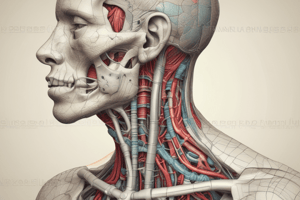Podcast
Questions and Answers
What is the role of the stylopharyngeus muscle during swallowing?
What is the role of the stylopharyngeus muscle during swallowing?
- It shortens the pharynx.
- It constricts the pharynx.
- It elevates the pharynx and larynx. (correct)
- It opens the auditory tube.
Which structure is located above the superior pharyngeal constrictor?
Which structure is located above the superior pharyngeal constrictor?
- Internal laryngeal nerve
- Inferior laryngeal nerve
- Auditory tube (correct)
- Glossopharyngeal nerve
Which nerve supplies the muscles of the pharynx for motor innervation?
Which nerve supplies the muscles of the pharynx for motor innervation?
- Vagus nerve (correct)
- Hypoglossal nerve
- Accessory nerve
- Glossopharyngeal nerve
What is the location of the palatopharyngeus muscle's origin?
What is the location of the palatopharyngeus muscle's origin?
What passes between the middle and inferior constrictors of the pharynx?
What passes between the middle and inferior constrictors of the pharynx?
Which part of the pharynx is solely responsible for air transmission?
Which part of the pharynx is solely responsible for air transmission?
What is the function of the oropharynx?
What is the function of the oropharynx?
What type of epithelium lines the nasopharynx?
What type of epithelium lines the nasopharynx?
Which structure is located at the inlet of the larynx?
Which structure is located at the inlet of the larynx?
The walls of the nasopharynx provide which key feature?
The walls of the nasopharynx provide which key feature?
Which muscle is NOT categorized as a constrictor muscle of the pharynx?
Which muscle is NOT categorized as a constrictor muscle of the pharynx?
What forms the continuous slope of the nasopharynx's roof and posterior wall?
What forms the continuous slope of the nasopharynx's roof and posterior wall?
Which part of the pharynx connects to the auditory tube?
Which part of the pharynx connects to the auditory tube?
What is the origin of the inferior constrictor muscle known as thyropharyngeus?
What is the origin of the inferior constrictor muscle known as thyropharyngeus?
Which muscle originates from the styloid process and inserts into the inner surface of the middle and inferior constrictors?
Which muscle originates from the styloid process and inserts into the inner surface of the middle and inferior constrictors?
What is the primary action of the superior pharyngeal constrictor during swallowing?
What is the primary action of the superior pharyngeal constrictor during swallowing?
Which insertion point is common to all constrictor muscles of the pharynx?
Which insertion point is common to all constrictor muscles of the pharynx?
Where does the palatopharyngeus originate?
Where does the palatopharyngeus originate?
Which structure serves as the attachment point for the upper end of the raphe of the pharynx?
Which structure serves as the attachment point for the upper end of the raphe of the pharynx?
What is the origin of the salpingopharyngeus muscle?
What is the origin of the salpingopharyngeus muscle?
Which part of the inferior constrictor muscle is associated with the cricoid cartilage?
Which part of the inferior constrictor muscle is associated with the cricoid cartilage?
Flashcards are hidden until you start studying
Study Notes
The Pharynx
- A wide muscular tube located behind the nose, mouth, and larynx.
- Divided into three parts: nasopharynx, oropharynx, and laryngopharynx.
- Plays a crucial role in breathing and swallowing.
- The wall of the pharynx is composed of five layers: mucosa, submucosa, pharyngobasilar fascia, muscular coat, and buccopharyngeal fascia.
Nasopharynx
- Situated behind the nose and above the lower border of the soft palate.
- Functions primarily as a respiratory passageway.
- Air passage remains patent due to rigid and non-collapsible walls.
- Lined by ciliated columnar epithelium.
- The mucous membrane receives blood supply and innervation.
- Communicates with the nasal cavity through the posterior nasal apertures.
- Communicates with the oropharynx at the pharyngeal isthmus.
Oropharynx
- Middle part is situated behind the oral cavity.
- Walls are formed by superior, middle, and inferior constrictors.
- Communicates with the nasopharynx via the pharyngeal isthmus.
- Communicates with the oral cavity via the oropharyngeal isthmus.
- The lateral wall houses the palatine tonsil located in the tonsillar fossa.
Laryngopharynx
- Lowest part is situated behind the larynx.
- Extends from the upper border of the epiglottis to the lower border of the cricoid cartilage.
- The anterior wall consists of the inlet of the larynx, cricoid, and arytenoid cartilages.
Muscles of the Pharynx
- Three constrictors: superior, middle, and inferior
- Constrictors: Work together to propel food down the esophagus during swallowing.
- Superior Constrictor: Originates from the pterygoid hamulus, pterygomandibular raphe, medial surface of the mandible, and side of the tongue.
- Middle Constrictor: Originates from the stylohyoid ligament and horns of the hyoid bone.
- Inferior Constrictor: Has two parts: thyropharyngeus and cricopharyngeus.
- Thyropharyngeus: Originates from the oblique line of the thyroid lamina and cricothyroid muscle.
- Cricopharyngeus: Originates from the cricoid cartilage.
- Constrictors: Insert onto a median raphe on the posterior wall of the pharynx.
- Longitudinal muscles: stylopharyngeus, salpingopharyngeus, and palatopharyngeus.
- Stylopharyngeus: Originates from the styloid process and inserts onto the inner surface of middle and inferior constrictors.
- Salpingopharyngeus: Originates from the auditory tube and inserts onto the thyroid cartilage and inferior constrictor.
- ** Palatopharyngeous:** Originates from the side of the hard palate and inserts onto the thyroid cartilage and blends with constrictor fibers.
Gaps Between Pharyngeal Muscles
- Above Superior Constrictor: Auditory tube, levator palati, ascending palatine artery.
- Between Superior and Middle Constrictor: Stylopharyngeus muscle, glossopharyngeal nerve
- Between Middle and Inferior Constrictor: Internal laryngeal nerve, superior laryngeal artery.
- Below Inferior Constrictor: Inferior laryngeal nerve.
Nerve Supply
- All muscles of the pharynx are innervated by the vagus nerve, except the stylopharyngeus muscle, which is innervated by the glossopharyngeal nerve.
Studying That Suits You
Use AI to generate personalized quizzes and flashcards to suit your learning preferences.




